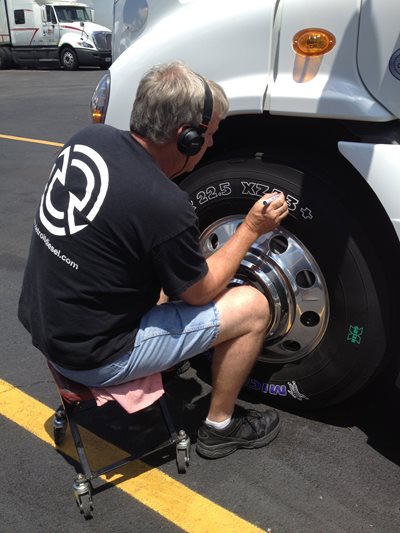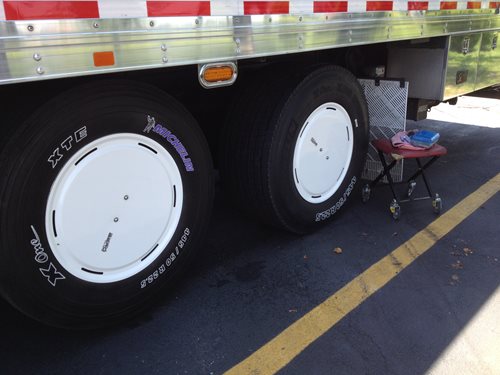
Bob painting steer tires to match new drive tires
| |
What is rolling resistance?
Rolling resistance, sometimes called rolling friction or rolling drag, is the force resisting the motion when a body (such as a ball, tire, or wheel) rolls on a surface. From Wikipedia, the free encyclopedia. There is more but this will do for the time being.
For me rolling resistance is - How hard it is to get a tire rolling and keep it rolling. The lower the resistance, the easier it is to get this accomplished, the less fuel we will use. Why is this important? Fuel is our number one cost as an owner operator. Purchasing tires that have the lowest rolling resistance will have a great impact on our fuel mileage.
How do we find out which tire is the lowest? Michelin has a chart that will compare almost any tire, theirs or others, to any other tire of your choosing. I will say that not all tires are on there, but most are. New tires are being released all the time and the testing must be done to determine the rolling resistance of the new tire.
In a recent blog we discussed choosing a tire that works best for your application. Rolling resistance was one of the factors mentioned. In this one we will discuss how much this factor has an effect on cost of ownership of the tire you choose.
To get an idea of what the rolling resistance is of your current tires is, or the tires your looking at purchasing, just Google "Michelin Truck Tires", click on "heavy duty" at the top of the page, click on the "tool box" at the top of the page, click on the "rolling resistance comparison" on the left side and start comparing. You will need to know the brand and model of each tire you want to compare. Once you find the tires you would like there is another tool to do a cost comparison of each tire in fuel usage, under "fuel savings calculator". Most truck tire manufacturers have the same type calculator on their web sites; I just like the one on Michelins.
Here are some calculations I made for the drive tires we just purchased. I compared the rolling resistance of the Continental HDL2 ECO Plus, RR 122, Michelin X-ONE XDA HT Plus, RR 122, Goodyear G392 SSD, RR 116, Bridgestone Greatec M825, RR 134, and the Michelin X-ONE XDA Energy, RR 94. In the cost calculator you need to set up the truck with the current tires you have then set it up with the proposed tires. If you are only changing the drives, make all the other tires the same on both platforms. All comparison tires were wide base radial 445 50 R 22.5 in size. Here is my results- the Michelin X-ONE XDA Energy had the lowest rolling resistance and that was my control tire since that is what we were replacing. So the fuel advantage savings/loss would be zero. The Goodyear G392SSD came in second using 680 gallons of fuel more than the control. The Continental HDL2 ECO Plus tied with the Michelin X-ONE XDA HT Plus using an extra 822 gallons of fuel. The Bridgestone Greater M825 brought up the rear using 1081 gallons of fuel more than our control tires. The comparison we used was for a tractor-trailer, single drive, because the calculator requires a trailer even though it asks about straight trucks. I also used the X ONE XRV RR 92 as control because the X ONE XDA Energy was not on the options list and it had the closest RR number.
Assuming 150,000 miles a year and $3.75 per gallon of fuel we can calculate the annual savings using the Michelin X-ONE XDA Energy over the others.
Goodyear cost us $2550
Continental and the other Michelin - $3082.50
Bridgestone $5134.75
In order for the other tires to be an economically sound decision they would have to be that much cheaper than the XDA Energy tires. I know the other tires are somewhat less expensive than the Michelin, but nowhere near what it would cost us in extra fuel. Some of the tires have a deeper tread and would last longer, maybe three years rather than two, so the extra fuel costs would triple instead of double. Still making a premium payout at purchase cost effective.
Knowing what we paid for the Michelin, our cost of ownership was right at $85 per month for our first set of drive tires. The Goodyear’s would have cost us $212 in extra fuel each month that savings will more than pay for the premium price of the Michelins, even if they are replaced more often. This is all using a perfect world scenario, reality is always different, but it will give you a good idea of the fuel usage differences of different tires. You can go into a tire purchase more informed. As I said do your research and find the tires that fit your operation in many brands then compare them against each other and see which one wins.
In our case the Michelin was the tire of choice, again.

New Michelin Wide Base Singles waiting for paint
| |